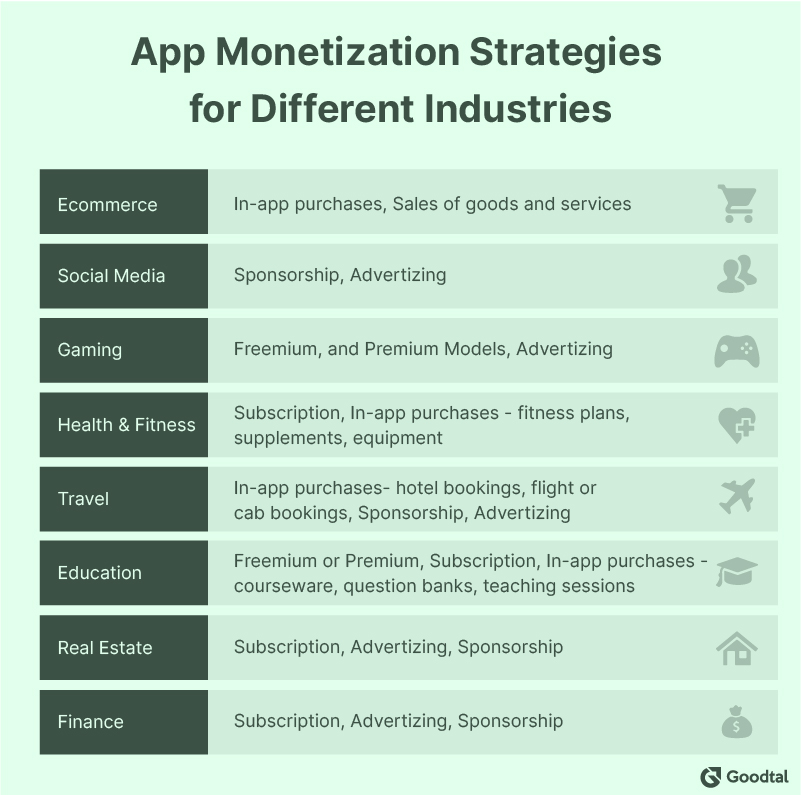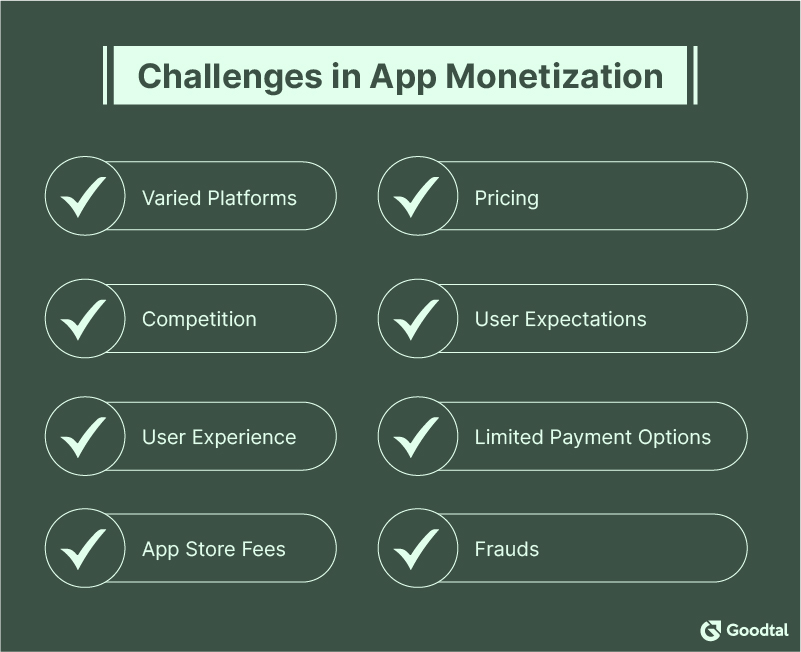
App monetization is an old concept, though, over the years, it has undergone tremendous transformation. To keep up with the competition, mobile app development companies are trying their best to deliver apps that can bring high revenue.
The revenue expectations and variety of app monetization strategies have also increased manifold. Businesses are thus competing with each other in leveraging app monetization to their benefit.
When we are discussing app monetization, it is pertinent to note these interesting statistics by Statista:
As of November 2022, 8% of apps from the U.S. monetized by being paid apps, while 3% of global apps monetized this way.
26% of U.S. apps generated revenue through ads, while the global average is 37%.
App monetization trends vary with demographics, industries, sectors, and even app scales. Businesses must keep abreast of all the possibilities to be able to select app monetization strategies that match their revenue needs.
Top App Monetization Strategies
This list of popular app monetization strategies will give businesses an overview of their characteristics.
Freemium & Premium Models
Though many businesses offer apps for free, one good way to monetize the app is to offer the basic version for free and advanced versions with added premium features for a price.
Another enhancement to this model is the try-before-buy model in which the app with premium features is allowed for free use for a limited period such as 15 days or a month. When the customer is convinced that he needs the premium features, he can buy the premium version.
In-app Purchases
In-app purchases, when it comes to ecommerce can simply be about selling products and services through the app. Some businesses sell products, and some others sell consultancy services, or even coaching through apps to derive revenue. This is the oldest and most well-known, app monetization technique.
However, for those who aren’t directly selling products or services through the app, there are other ways for in-app purchases such as offering additional features, access to premium content, etc.
Subscription
As we all know, subscription-based app monetization allows access to a collection of additional material such as articles, blogs, and vlogs, for a monthly, yearly, or custom period. These are given to the subscribers for a price and are thus not accessible to all the users or all the time. This is thus a need-based, flexible, and customized model that reaps very good revenue as the subscribers are those who are genuinely interested in the content they are paying for.
Users should be allowed to choose categories or types of content that they want to subscribe. For example, some could simply be interested in videos, and others want all the available material. However, this also implies that for profit-making, businesses will have to include a variety of content for the different needs of the users.
This model is suitable or lucrative for some industries or businesses. For example, educational apps or entertainment apps can allow subscription-based additional content downloads such as course material, lectures, practical AR-enabled training, movies, songs, etc. However, for ecommerce, the subscription model might not be very useful. Continue reading the blog and you will find an infographic that lists the best monetization model for apps of different industries.
Suggested Reading: 10 Must-Have Features of an Education Mobile Application
Advertizing
Many businesses allow advertising through their mobile app to generate revenue. This is possible through Banner Ads, Interstitial Ads, or Native Ads that blend naturally with your content and app design and are displayed in the app. In-app ads are a very rich source of app revenue though many businesses are not comfortable advertising other products or services through their apps.
Though the smarter businesses collaborate with supplementary products or services businesses to reinforce both businesses and generate revenue in the process. This is similar to affiliate marketing through apps and it is trending across the mobile app development industry.
Selling Products
Undoubtedly the best way for app monetization is through in-app selling. As users are now switching largely to online purchasing worldwide, it is a very successful and commonly used model for app monetization that the majority of businesses leverage.
Not all businesses have products or services to sell through their apps, but there can be smart ideas for selling that almost all can leverage though they do not have their own product or service to sell through their app. This is similar to advertising complementary products on the app.
Sponsorship
Businesses can partner with famous brands to incorporate their products or services in the app for a fee. This sponsorship model mostly faces a conflict of interest as businesses would not want to promote other businesses through their apps and so many businesses do not opt to go for it.
Crowdfunding
So many startups rely on crowdfunding. You can use your app to pitch your idea to financers and investors. This app monetization strategy has a limited scope and so is used only by specific businesses.

Challenges in App Monetization
To be effective, app monetization initiatives must overcome the following app monetization challenges.
Varied Platforms
Although many believe app monetization strategies do not vary with different platforms, in reality, they do. As we all know, Android and iOS have different types of audiences, with a range of preferences. Keeping in mind the needs of the audience for each OS, businesses must design relevant app monetization strategies. This challenge can easily be taken care of if businesses select from the best Android app development companies or iOS app development companies who are familiar with the specific needs of these platforms.
Pricing
While it is essential to monetize your app, it is also important to know where to stop as the users will not pay unless they find value for their money. So, the prices for paid features and services should be optimized such that you generate revenue without losing customers. The customers should ideally be convinced that they are getting the service for a fair price. Pricing may sound easy, but it’s difficult to evaluate such fair pricing that considers user needs and accommodates your revenue requirements at the same time.
Competition
So many businesses are relying on app monetization these days and so there is huge competition among all. It is thus essential to research the areas that others are monetizing and for what price. It is also important to know what is generating more revenue for them and what fails to generate any. Based on this information, monetization decisions should be made.
User Expectations
Many businesses are offering app features, content, or services for free. So, if you start charging for the same, they can switch over to competitor apps that are offering the same for free. In an attempt to monetize, you would not want to lose a customer base.
User Experience
App developers and designers are well aware of the significance of user experience in the success of their apps. They ensure all measures that can deliver a better user experience, no matter if it requires more time and resources to develop the app. App monetization, however, poses challenges in their endeavors.
Too much monetization can lead to compromise on user experience. For example, the users may feel annoyed with ads on your app and they could find the ads irrelevant. And, no matter how user-friendly the app is, the user will still reject it. So, businesses must optimize to balance the revenue drawn through app monetization and the app experience. Remember, you do want users to be able to sustain any revenue!
Suggested Reading: Top Design Tips to Perfect User Experience in Apps
Limited Payment Options
Due to regulations and trends, users in some parts of the world may not have access to popular payment methods. This makes it impossible for businesses to monetize through in-app purchases or subscriptions.
App Store Fees
App stores charge fees for hosting the apps. This is an additional cost acting as a determinant of what the business must earn from the app to make it profitable.
Frauds
Mobile apps often face fraudulent behavior from hackers, impacting the safety of data. If it is about financial data, fraud can have serious consequences. So, when planning to monetize their apps, businesses must ensure a robust and secure app.

Wrapping Up!
The ultimate goal of businesses is revenue. Although all businesses are developing apps, very few are able to monetize the app effectively for revenue. The tips and suggestions in this blog will help you identify the perfect monetization strategy for your business. It will also prepare you for the challenges in monetization so that you can prepare and prevent any bottlenecks.
However, all app monetization initiatives will fail if you do not have a robust, secure, and user-friendly app. So, make sure you get your app developed by the best mobile app developers.
If you are going for specific Android or iOS app development, select developers specializing in these separately. While if you are looking for cross-platform app development using popular frameworks, you need specialists for that framework. For example, if you want to go for Flutter cross-platform app development framework, do check the list of best Flutter development companies.
